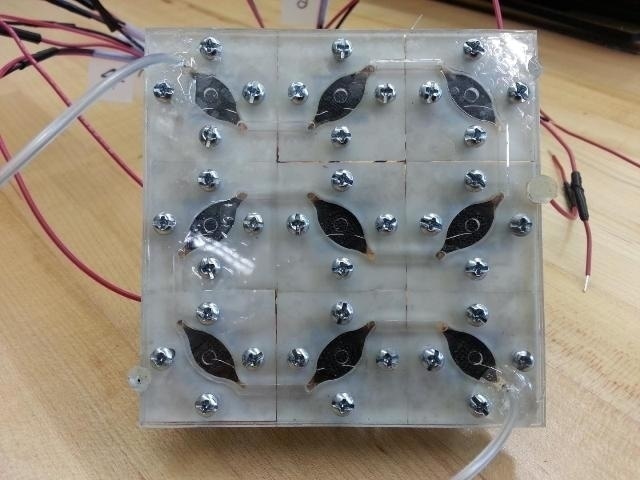Apr 12 2016
A team of researchers from Binghamton University have successfully connected nine bio-solar cells into a bio-solar panel for the first time ever, facilitating the next step in the development of bacteria-powered energy.
 These are nine biological-solar (bio-solar) cells connected into a bio-solar panel. The panel has generated the most wattage of any existing small-scale bio-solar cells - 5.59 microwatts (Photo credit: Seokheun "Sean" Choi)
These are nine biological-solar (bio-solar) cells connected into a bio-solar panel. The panel has generated the most wattage of any existing small-scale bio-solar cells - 5.59 microwatts (Photo credit: Seokheun "Sean" Choi)
Using this novel bio-solar panel the team generated electricity continuously at a high wattage of 5.59 mW, which is not possible with any currently available small-scale bio-solar cells.
Once a functional bio-solar panel becomes available, it could become a permanent power source for supplying long-term power for small, wireless telemetry systems as well as wireless sensors used at remote sites where frequent battery replacement is impractical.
Seokheun "Sean" Choi, Assistant Professor of Electrical and Computer Engineering, Binghamton University
Choi is the corresponding author of the paper titled "Biopower generation in a microfluidic bio-solar panel", which has all of the details about the research.
This research could also enable crucial understanding of the photosynthetic extracellular electron transfer processes in a smaller group of microorganisms with excellent control over the microenvironment, thereby enabling a versatile platform for fundamental bio-solar cell studies.
Seokheun "Sean" Choi, Assistant Professor of Electrical and Computer Engineering, Binghamton University
In the new study, cyanobacteria were used as a clean and sustainable source of energy. These bacteria are found in many aquatic and terrestrial habitats on Earth. Last year the team tried to build an improved bio-solar cell by altering the materials used in the cell’s cathodes and anodes, and also produced a tiny microfluidic-based single-chambered device to accommodate the bacteria instead of the traditional, dual-chambered bio-solar cells. This time the team connected nine similar looking bio-solar cells in a 3x3 pattern to produce a stackable and scalable bio-solar panel. The panel constantly produced electricity from respiratory and photosynthesis activities of the bacteria during a 12-hour day-night period totaling 60 hours.
"Bio-solar cell performance has improved significantly through miniaturizing innovative device architectures and connecting multiple miniature cells in a panel," the report said. "This could result in barrier-transcending advancements in bio-solar cells that could facilitate higher power/voltage generation with self-sustainability, releasing bio-solar cell technology from its restriction to research settings, and translating it to practical applications in real-world."
However this breakthrough research still lacked efficiency, as a conventional 60-cell in a 6x10 configuration solar panel placed on the roof of a residential house generated about 200 W of electrical power at a specified moment, whereas the cells with a similar configuration from this current research were able to produce approximately 0.00003726 W. Nevertheless, this research paves the way for futuristic research of the bacteria itself.
It is time for breakthroughs that can maximize power-generating capabilities/energy efficiency/sustainability. The metabolic pathways of cyanobacteria or algae are only partially understood, and their significantly low power density and low energy efficiency make them unsuitable for practical applications. There is a need for additional basic research to clarify bacterial metabolism and energy production potential for bio-solar applications.
Seokheun "Sean" Choi, Assistant Professor of Electrical and Computer Engineering, Binghamton University
The research was also authored by Xuejian Wei, a graduate student in Binghamton University, and Hankeun Lee, who will graduate from Binghamton in May.
The fabrication facilities for the research were provided by the Binghamton University Nanofabrication Lab. Funding was provided by the University Research Foundation (Interdisciplinary Collaborations Grants (ICG) Program/Transdisciplinary Areas of Excellence).
The research is available online and will be published in the June edition of the journal Sensors and Actuators B: Chemical.